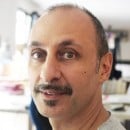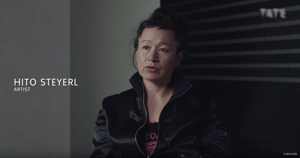In this film, the German artist Hito Steyerl explains that she has made a kind of manual on how to become invisible. Her goal was to ponder over a strange question: in modern society, how can you make yourself not be seen?
This question leads to further reflections.
In a recent conference, the artist stated: “I came to understand that many things are completely invisible even when they are right in front of our eyes”. But, on the other hand, her video is also entitled, “Being invisible can be deadly”.
These observations of an artist that has been exploring the role played by technology, the circulation of images and Artificial Intelligence in shaping our emotions and our experience of reality are not surprising. The search is disorienting and surprising, because it often changes perspective, putting itself in the shoes of “someone else”.
In an installation in 2016, entitled “Hell Yeah We Fuck Die”, Steyerl investigated the performance and the extreme precariousness of robots. And in her recent “The City of Broken Windows”, on display until June 30 at the Rivoli Castle (Turin), she uses screens, windows and liquid crystals, which tie together in a work of art that revolves around recordings alternated with sounds, documenting the learning process of Artificial Intelligence, which in the industry and technology of security means teaching it how to recognize the sound of breaking windows.
For Steyerl, this is an opportunity to investigate how Artificial Intelligence can influence the urban environment and the production of art in public spaces.
The artist explains:
“I try to work a lot with new technology. Works that are a combination of events that are crafted (fiction) and those that are documented. A blend of real people and invented characters, parts that are created and events that have really happened. (…)
The circulation of images leads to the idea of the image can be something liquid and that has different states. But images need physicality and some kind of carrier. It is a complete illusion that the digital image is “not material”. In this room we have a projector and a screen: even if the images are digital, they are physical”.
According to Steyerl it cannot be ruled out that one day art will be able to interact with people, adapting itself to the taste of the individual thanks to facial recognition and programmes that teach it to interpret the expressions of human beings.
And we have to abandon the illusion that all images are a personal creation: they are almost always the result of the interaction with very broad and omnipresent computer networks.
However, none of this is for certain, it is only an hypothesis on the outcome of a match that is taking place in front of our eyes and the end of which is still be to written.

